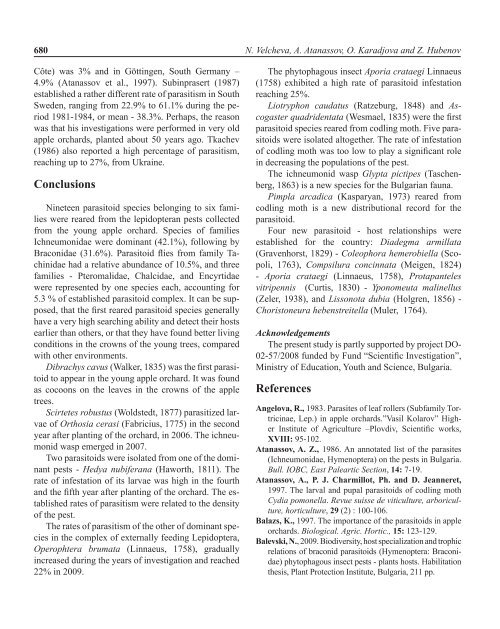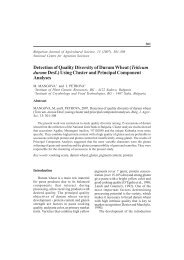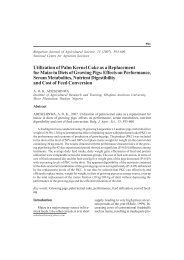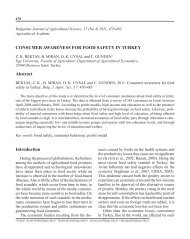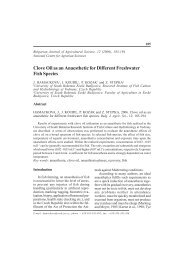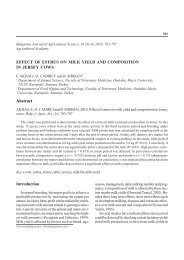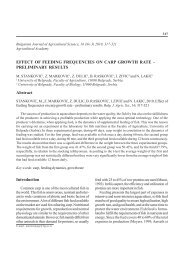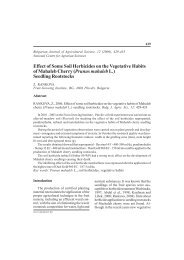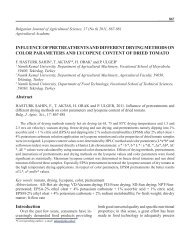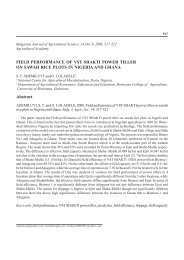parasitoid assemblages isolated from externally feeding ...
parasitoid assemblages isolated from externally feeding ...
parasitoid assemblages isolated from externally feeding ...
You also want an ePaper? Increase the reach of your titles
YUMPU automatically turns print PDFs into web optimized ePapers that Google loves.
680 N. Velcheva, A. Atanassov, O. Karadjova and Z. HubenovCôte) was 3% and in Göttingen, South Germany –4.9% (Atanassov et al., 1997). Subinprasert (1987)established a rather different rate of parasitism in SouthSweden, ranging <strong>from</strong> 22.9% to 61.1% during the period1981-1984, or mean - 38.3%. Perhaps, the reasonwas that his investigations were performed in very oldapple orchards, planted about 50 years ago. Tkachev(1986) also reported a high percentage of parasitism,reaching up to 27%, <strong>from</strong> Ukraine.ConclusionsNineteen <strong>parasitoid</strong> species belonging to six familieswere reared <strong>from</strong> the lepidopteran pests collected<strong>from</strong> the young apple orchard. Species of familiesIchneumonidae were dominant (42.1%), following byBraconidae (31.6%). Parasitoid flies <strong>from</strong> family Tachinidaehad a relative abundance of 10.5%, and threefamilies - Pteromalidae, Chalcidae, and Encyrtidaewere represented by one species each, accounting for5.3 % of established <strong>parasitoid</strong> complex. It can be supposed,that the first reared <strong>parasitoid</strong> species generallyhave a very high searching ability and detect their hostsearlier than others, or that they have found better livingconditions in the crowns of the young trees, comparedwith other environments.Dibrachys cavus (Walker, 1835) was the first <strong>parasitoid</strong>to appear in the young apple orchard. It was foundas cocoons on the leaves in the crowns of the appletrees.Scirtetes robustus (Woldstedt, 1877) parasitized larvaeof Orthosia cerasi (Fabricius, 1775) in the secondyear after planting of the orchard, in 2006. The ichneumonidwasp emerged in 2007.Two <strong>parasitoid</strong>s were <strong>isolated</strong> <strong>from</strong> one of the dominantpests - Hedya nubiferana (Haworth, 1811). Therate of infestation of its larvae was high in the fourthand the fifth year after planting of the orchard. The establishedrates of parasitism were related to the densityof the pest.The rates of parasitism of the other of dominant speciesin the complex of <strong>externally</strong> <strong>feeding</strong> Lepidoptera,Operophtera brumata (Linnaeus, 1758), graduallyincreased during the years of investigation and reached22% in 2009.The phytophagous insect Aporia crataegi Linnaeus(1758) exhibited a high rate of <strong>parasitoid</strong> infestationreaching 25%.Liotryphon caudatus (Ratzeburg, 1848) and Ascogasterquadridentata (Wesmael, 1835) were the first<strong>parasitoid</strong> species reared <strong>from</strong> codling moth. Five <strong>parasitoid</strong>swere <strong>isolated</strong> altogether. The rate of infestationof codling moth was too low to play a significant rolein decreasing the populations of the pest.The ichneumonid wasp Glypta pictipes (Taschenberg,1863) is a new species for the Bulgarian fauna.Pimpla arcadica (Kasparyan, 1973) reared <strong>from</strong>codling moth is a new distributional record for the<strong>parasitoid</strong>.Four new <strong>parasitoid</strong> - host relationships wereestablished for the country: Diadegma armillata(Gravenhorst, 1829) - Coleophora hemerobiella (Scopoli,1763), Compsilura concinnata (Meigen, 1824)- Aporia crataegi (Linnaeus, 1758), Protapantelesvitripennis (Curtis, 1830) - Yponomeuta malinellus(Zeler, 1938), and Lissonota dubia (Holgren, 1856) -Choristoneura hebenstreitella (Muler, 1764).AcknowledgementsThe present study is partly supported by project DO-02-57/2008 funded by Fund “Scientific Investigation”,Ministry of Education, Youth and Science, Bulgaria.ReferencesAngelova, R., 1983. Parasites of leaf rollers (Subfamily Tortricinae,Lep.) in apple orchards.”Vasil Kolarov” HigherInstitute of Agriculture –Plovdiv, Scientific works,XVIII: 95-102.Atanassov, A. Z., 1986. An annotated list of the parasites(Ichneumonidae, Hymenoptera) on the pests in Bulgaria.Bull. IOBC, East Paleartic Section, 14: 7-19.Atanassov, A., P. J. Charmillot, Ph. and D. Jeanneret,1997. The larval and pupal <strong>parasitoid</strong>s of codling mothCydia pomonella. Revue suisse de viticulture, arboriculture,horticulture, 29 (2) : 100-106.Balazs, K., 1997. The importance of the <strong>parasitoid</strong>s in appleorchards. Biological. Agric. Hortic., 15: 123-129.Balevski, N., 2009. Biodiversity, host specialization and trophicrelations of braconid <strong>parasitoid</strong>s (Hymenoptera: Braconidae)phytophagous insect pests - plants hosts. Habilitationthesis, Plant Protection Institute, Bulgaria, 211 pp.


